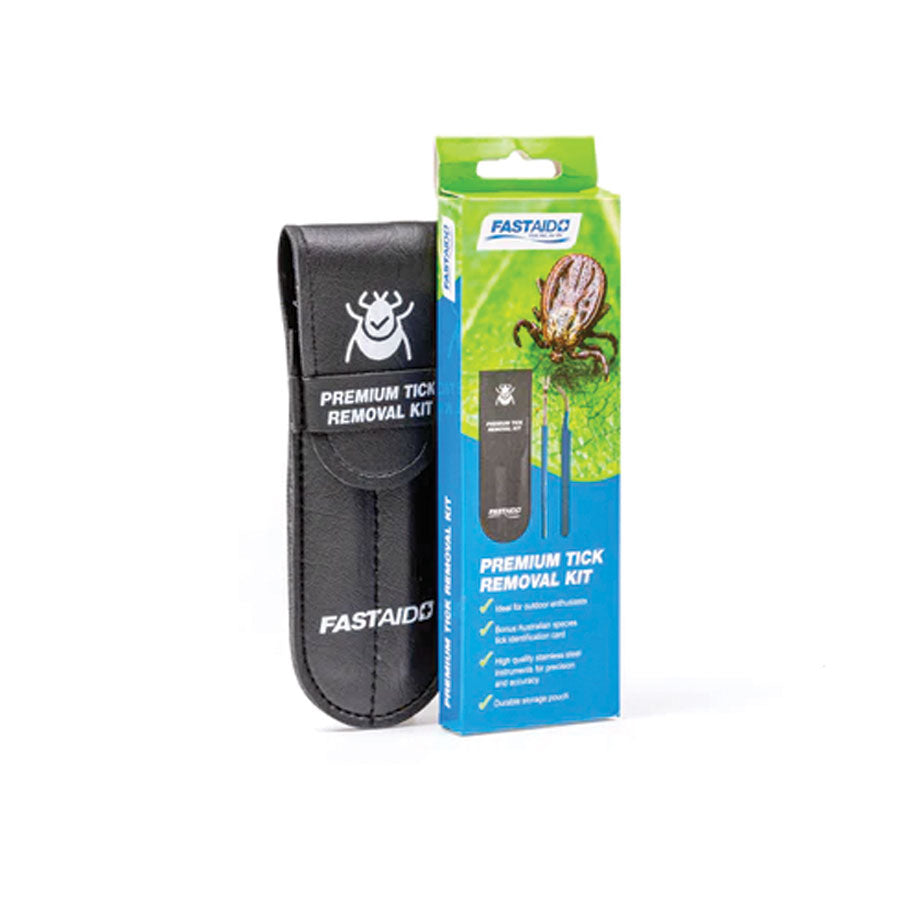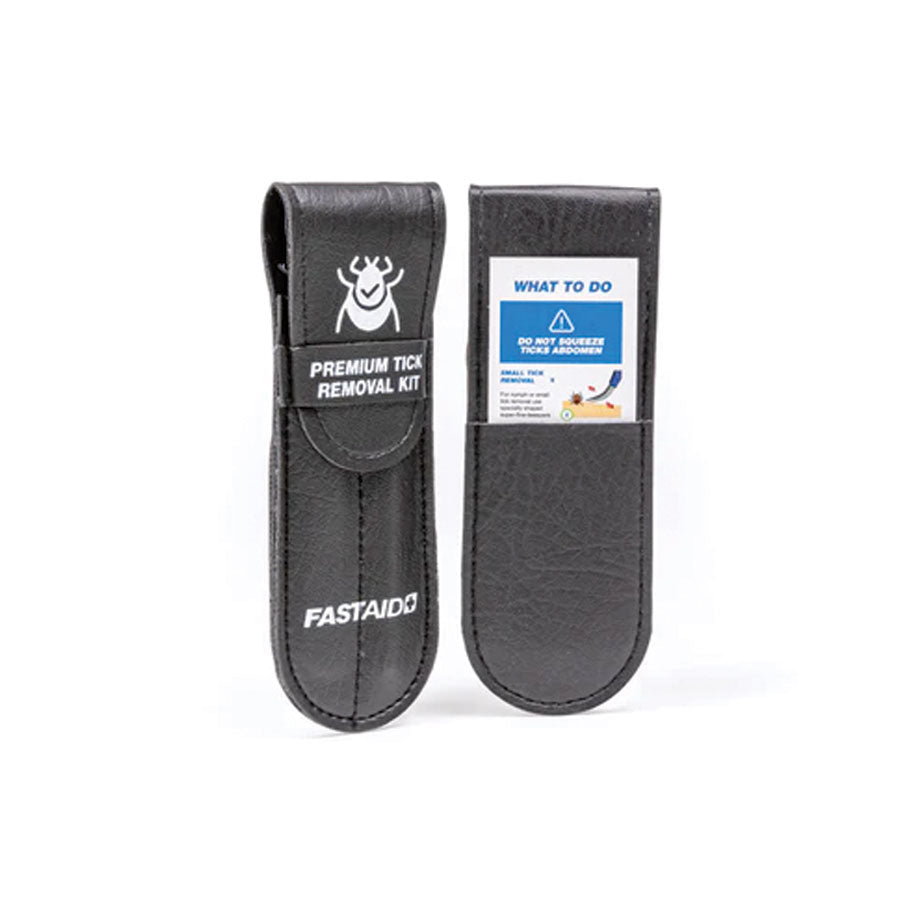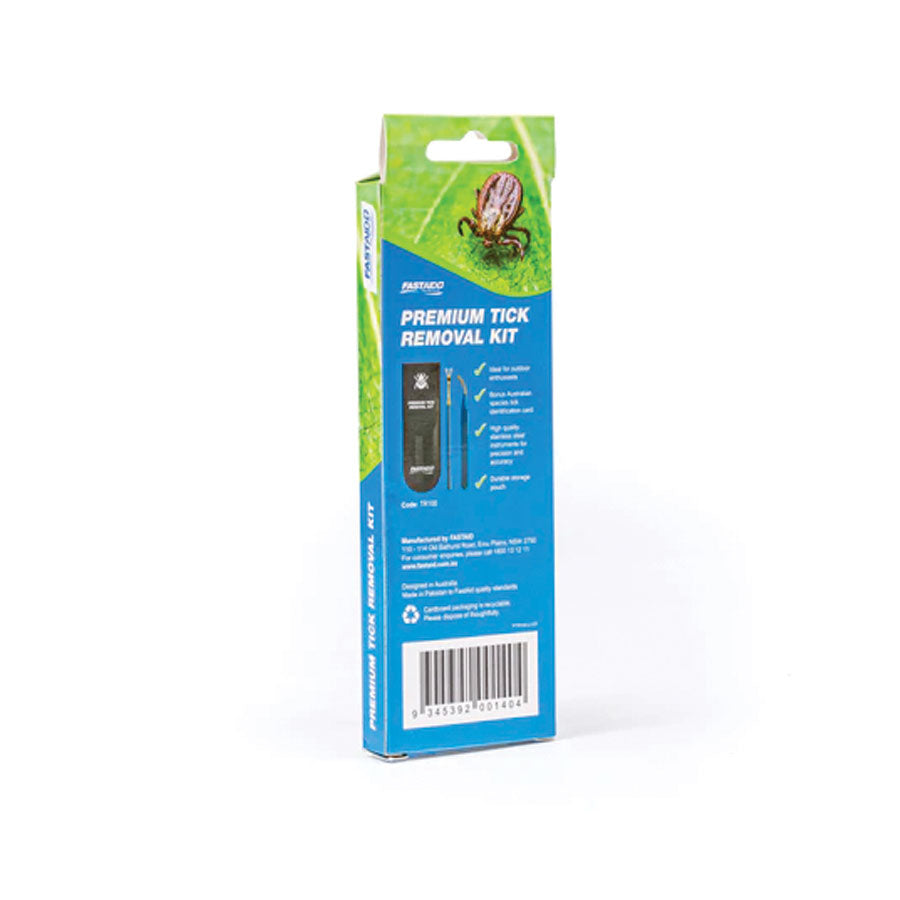


WMFA-TR100
Warrior Medical Fast Aid Premium Tick Removal Kit 10 Pack
Shipping & Returns
Tactical distributors Pty Ltd (Tactical Gear) ships from various warehouses throughout Australia and the United States. Shipping timelines are specified on each product page.
Ideal for outdoor enthusiasts, people or pets
Kit includes a quality tick remover for safely removing larger embedded ticks, and specially shaped super-fine tweezers for removing nymphs and small ticks
High quality stainless steel instruments
Kit contains high quality stainless steel instruments to ensure ticks can be safely removed with precision and accuracy.
Bonus tick identification card
Includes a tick identification card to easily identify the most common species of ticks in Australia, along with key steps to take to safely remove ticks.
Durable storage pouch
Instruments are packed in a quality leatherette storage pouch, ideal for slipping into your first aid kit, pocket or backpack.
How to safely remove ticks?
When you're heading outdoors, it's good to be prepared for any potential first aid emergencies. A common first aid incident in the Australian bush are tick bites.
Ticks are small, blood-sucking parasites that are commonly found in wooded or grassy areas. They attach themselves to humans, pets, and other animals in order to feed on their blood. Ticks are often carriers of diseases, including Lyme disease.

Ticks can be dangerous because they can transmit diseases to humans and animals through their bites. The risk of disease transmission depends on the type of tick and the location where the bite occurred. In some areas, ticks are more likely to carry diseases than in others, and the symptoms of tick-borne illnesses can range from mild to severe.

If you live in an area where ticks are common, it's important to take precautions to reduce your risk of tick bites, such as wearing long sleeves and pants, using insect repellent, and staying on designated trails when hiking.
However stringent you may be at avoiding ticks - it's best to be prepared with an appropriate removal tool. We've recently released our premium tick remover kit which is perfect for taking on any outdoor adventure or holiday.
If you do find a tick on your skin, remove it as soon as possible to reduce the risk of disease transmission.
Here's how to remove a tick:

-
Gather your supplies: You will need Warrior Medical Fast Aid Premium Tick Removal Kit, rubbing alcohol, and a clean cloth or paper towel.
-
Clean the area: Clean the skin around the tick with rubbing alcohol.
-
Identify the size of the tick and grasp:
For small ticks or nymphs, using the specifically shaped super-fine-tweezers, grasp the tick as close to the skin as possible and pull upward with a steady, even pressure.
For larger ticks, use the tick removal tool and use a scoop and lift motion to remove the tick.
Do not twist or crush the tick, as this can cause its body to break apart and release more infected fluids into the skin. -
Clean the bite area: Clean the bite area again with rubbing alcohol and a clean cloth or paper towel.
-
Dispose of the tick: Place the tick in a sealed container or wrap it in tape and dispose of it in a secure location.
It's a good idea to keep an eye on the bite area for any signs of infection, such as redness, swelling, or a rash. If you develop any of these symptoms or symptoms of a tick-borne illness, seek medical attention as soon as possible.
Ideal for outdoor enthusiasts, people or pets
Kit includes a quality tick remover for safely removing larger embedded ticks, and specially shaped super-fine tweezers for removing nymphs and small ticks
High quality stainless steel instruments
Kit contains high quality stainless steel instruments to ensure ticks can be safely removed with precision and accuracy.
Bonus tick identification card
Includes a tick identification card to easily identify the most common species of ticks in Australia, along with key steps to take to safely remove ticks.
Durable storage pouch
Instruments are packed in a quality leatherette storage pouch, ideal for slipping into your first aid kit, pocket or backpack.
How to safely remove ticks?
When you're heading outdoors, it's good to be prepared for any potential first aid emergencies. A common first aid incident in the Australian bush are tick bites.
Ticks are small, blood-sucking parasites that are commonly found in wooded or grassy areas. They attach themselves to humans, pets, and other animals in order to feed on their blood. Ticks are often carriers of diseases, including Lyme disease.

Ticks can be dangerous because they can transmit diseases to humans and animals through their bites. The risk of disease transmission depends on the type of tick and the location where the bite occurred. In some areas, ticks are more likely to carry diseases than in others, and the symptoms of tick-borne illnesses can range from mild to severe.

If you live in an area where ticks are common, it's important to take precautions to reduce your risk of tick bites, such as wearing long sleeves and pants, using insect repellent, and staying on designated trails when hiking.
However stringent you may be at avoiding ticks - it's best to be prepared with an appropriate removal tool. We've recently released our premium tick remover kit which is perfect for taking on any outdoor adventure or holiday.
If you do find a tick on your skin, remove it as soon as possible to reduce the risk of disease transmission.
Here's how to remove a tick:

-
Gather your supplies: You will need Warrior Medical Fast Aid Premium Tick Removal Kit, rubbing alcohol, and a clean cloth or paper towel.
-
Clean the area: Clean the skin around the tick with rubbing alcohol.
-
Identify the size of the tick and grasp:
For small ticks or nymphs, using the specifically shaped super-fine-tweezers, grasp the tick as close to the skin as possible and pull upward with a steady, even pressure.
For larger ticks, use the tick removal tool and use a scoop and lift motion to remove the tick.
Do not twist or crush the tick, as this can cause its body to break apart and release more infected fluids into the skin. -
Clean the bite area: Clean the bite area again with rubbing alcohol and a clean cloth or paper towel.
-
Dispose of the tick: Place the tick in a sealed container or wrap it in tape and dispose of it in a secure location.
It's a good idea to keep an eye on the bite area for any signs of infection, such as redness, swelling, or a rash. If you develop any of these symptoms or symptoms of a tick-borne illness, seek medical attention as soon as possible.





